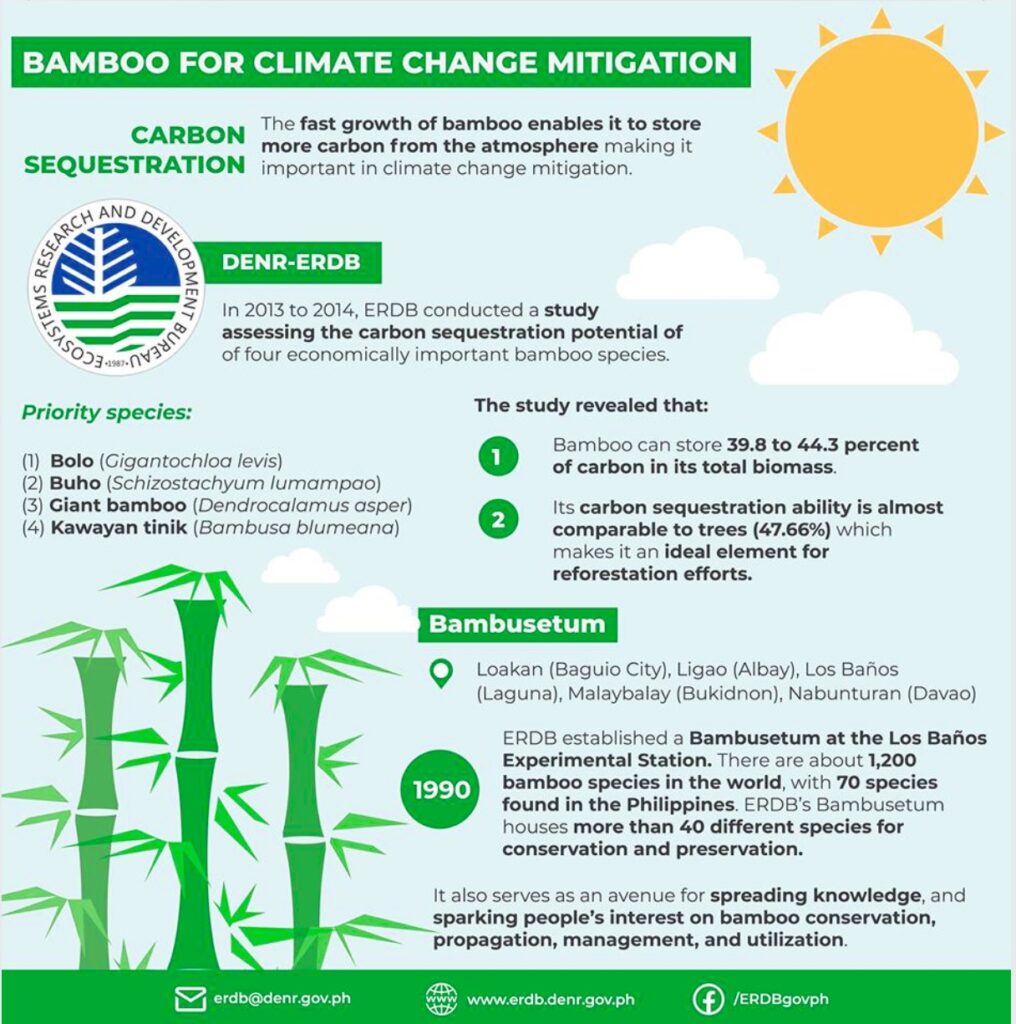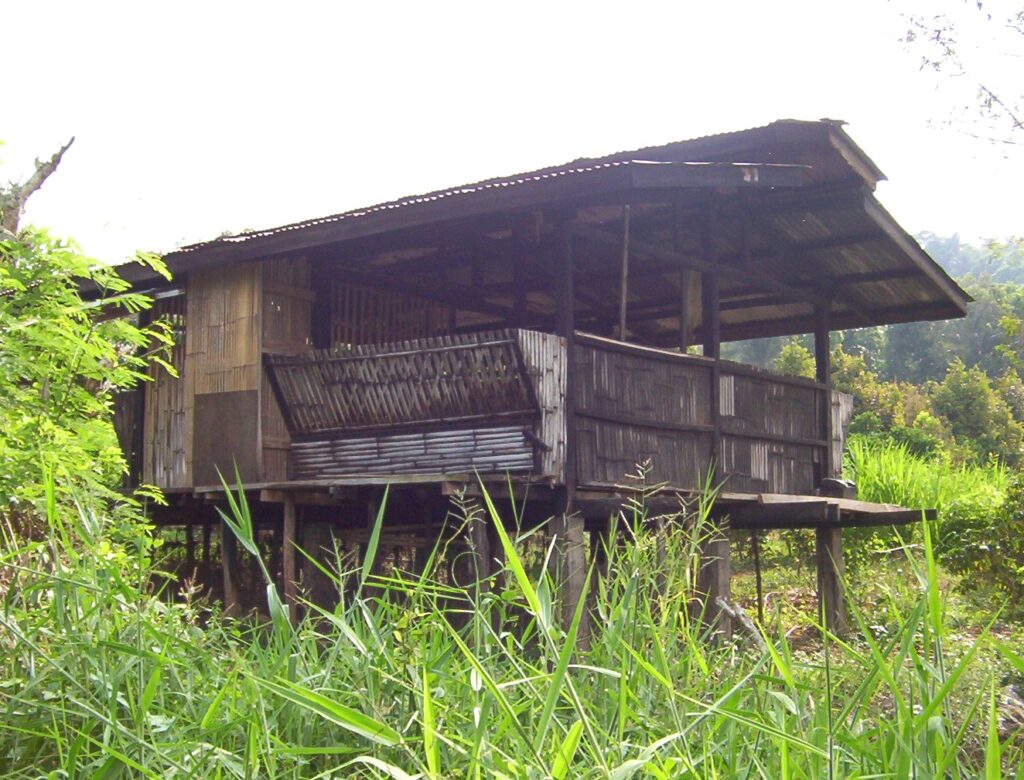Text and Photos by Henrylito D. Tacio
If it has to heed the report of the Nobel Prize-winning Intergovernmental Panel on Climate Change (IPCC), the world has only 11 years “to beef up its efforts to reduce global temperature before it crosses the threshold leading to climate catastrophe.”
One of the best ways to save the world from the effects of climate change is by planting trees – “at least a trillion of them, and fast,” reported Laura Geggel in an article published by Live Science.
“That may sound like a lot of trees, but the Earth has room for their gnarled bows and branches,” Geggel explained. Citing a study that excluded cities and agricultural areas, “researchers found that the planet has nearly 9 million square kilometers to spare for trees.”
A tree that may just do the trick is bamboo, which is common in the Philippines. Bamboo, said the International Network for Bamboo and Rattan (INBAR), is “a strategic resource for countries to reduce the effects of climate change.”
“A number of bamboo species are potential tools for carbon sequestration and combating climate change,” said INBAR Director General Hans Friederich on behalf of its 40 member countries.
“Bamboo plants store carbon at a fast rate, and bamboo products can effectively ‘displace’ more emissions-intensive materials such as cement, steel and plastic,” Friederich pointed out.

Recent INBAR research suggests (well-managed) bamboo can store 200 to 400 tons of carbon per hectare per year. “With such high carbon storage rates, there is clearly potential for countries to integrate bamboo into their climate mitigation plans,” he said.
Patricia Espinosa, executive secretary of the United Nations Framework Convention on Climate Change, agreed. “Bamboo and rattan can make an important difference in the fight against climate change,” she said. “Nature-based solutions like bamboo do not just contribute to sustainable development, they also help build the kind of world we want.”
In the Philippines, the Ecosystems Research and Development Bureau (ERDB) is the leading bureau that pushes bamboo for climate change adaptation. “Bamboo is considered a valuable economic and environmental resource, and ERDB hopes to continue to innovate ways on increasing awareness on the promising potentials of bamboo, especially in attaining environmental sustainability and economic resiliency,” said Dr. Sofio B. Quintana, ERDB director and national coordinator of the bamboo plantation development project.
ERDB is the principal research and development arm of the Department of Environment and Natural Resources (DENR). Having researched bamboo since 1987, it has established a Bambusetum at the Los Baños Experimental Station to conserve and preserve more than 40 different rare and endangered bamboo species.
From 2013 to 2014, ERDB conducted a study assessing the carbon sequestration of four economically important bamboo species: “bolo” (Gigantochloa levis), “buho” (Schizostachyum lumampas), giant bamboo (Dendrocalamus asper), and “kawayan-tinik” (Bambusa blumeana).
The study results showed bamboo could store 39.8% to 44.3% of carbon’s total biomass. “Its carbon sequestration ability is almost comparable to trees (47.66%) which makes it an ideal element for reforestation efforts,” the ERDB said.
Carbon sequestration is defined as a natural or artificial process by which carbon dioxide is removed from the atmosphere and held in solid form. Carbon dioxide is the primary greenhouse gas that also includes methane and nitrous oxide. The carbon overload in the atmosphere is reportedly caused mainly by burning fossil fuels like coal, oil, and gas and by cutting down and burning forests.
“Climate change is real, and we are experiencing its effects every day,” Deputy Speaker Loren Legarda said in a statement. “The change in weather patterns, the worsening calamities, and the disturbances seen in ecosystems – these are only some of its effects.

“If we do not stop it or learn to adapt to it, we will be effectively destroying the world we live in,” the Congresswoman from Antique continued. “In a few years or so, we will be producing less output from our farms, drinking toxic water, and seeing worsening pollution of rivers and oceans, if we do not adapt.”
“Bamboo is not a weed, it’s a flowering plant. Bamboo is a magnificent plant,” commented Steve Lacy. Thomas Alva Edison supposedly used a carbonized bamboo filament in his experiments in developing the light bulb. Alexander Graham Bell also used bamboo for his first phonograph needle. “You can eat, wear, and build with bamboo,” said Michael Block.
There are a million other uses of bamboo. According to an article, which appeared in Reader’s Digest, bamboo “is delicate enough to be used in phonograph needles, yet strong enough to be used in bridge construction.” As such, bamboo can replace or indirectly decrease the consumption of three critically scarce resources: wood, metal, and oil.
Already, bamboo is being used as scaffolding and concrete reinforcement in the construction of buildings. In Bangladesh, where 73% of the population lives in bamboo houses, bamboo provides pillars, walls, window frames, rafters, room separators, ceilings, and roofs. It is used throughout rural Asia to build bridges, from the sophisticated technology of suspension bridges to the simpler pontoon bridges.
In the Philippines, bamboo is also indispensable in the fishing and banana industry, particularly in the Davao region. Fishers use bamboo as a material for making rafts, fishing rods, outriggers for bancas, and for fish pens. In salt-water areas, bamboo is used as stakes in the culture of mussels and oysters.
Bamboo is also used to manufacture musical instruments like horns, clarinets, saxophones, flutes, piccolos, xylophones, and drums. In Java, Indonesia, 20 different musical instruments have been fashioned out of bamboo. The world-famous bamboo organ at the Roman Catholic Church of Las Piñas is a historical example of bamboo’s importance.
There are also sophisticated bamboo uses – charcoal for electric batteries, liquid diesel fuel obtained by distillation, and enzymes and media for shoot extracts used for culturing disease-causing bacteria. The white powder produced on young culms’ outer space for the isolation of a crystalline compound is medically useful.

The young bamboo shoots are a good source of vitamins and minerals. Nutritionists claim that bamboo shoot is low in carbohydrates and crude fat, and it has plenty of crude fiber, making it an ideal vegetable for people who want to reduce it. Eighteen amino acids are reportedly present in bamboo shoots. Just a health warning: shoots of some species contain toxins that need to be leached or boiled out before they can be eaten safely.
Under the environmental aspect, bamboo is more valuable than all those mentioned above: bamboo contributes to fighting climate change. “Bamboo plays an important role in climate change mitigation as it absorbs more carbon dioxide and releases more oxygen into the atmosphere than trees,” said Legarda, who was chair of the Senate Committee on Climate Change when she was still with the Senate.
Despite bamboo’s potential in curbing climate change, Friederich said many decision-makers, planners, and national sustainable development action plans have not yet taken account of this resource and the benefits it can bring to society.
“Properly applied, bamboo will help many low and middle-income countries achieve their sustainable development goals,” Friederich believed.
In the Philippines, bamboo grows anywhere. Often, it will grow on marginal farm areas, not much good for anything else. “It is a pity that we have neglected this important crop for so long,” deplores Jethro P. Adang, the director of Davao-based Mindanao Baptist Rural Life Center.
Unknowingly, bamboo is a superb reforestation species due to its varied utility and importance in controlling soil erosion and stabilizing riverbanks. There are three main reasons why bamboo is a superb crop for cogonal areas: both bamboo and cogon belong to the same plant family and so are compatible; bamboo grows faster and taller than cogon and can quickly shade out the later, and bamboo is not killed when the cogonal area is burned accidentally or deliberately.
“Bamboo is considered to be the best conservation material because of its low maintenance compared to other plantations aside from the fact that there is a high return on investment and faster payback in bamboo,” said Dr. Henry A. Adornado, ERDB executive director.
The bamboo business, however, is labor-intensive, more so during the first two years of operation. Studies have shown that labor alone eats around 90 percent of the total production cost. But the beauty of bamboo growing lies in passing the first two critical growing years.
“If the bamboo survives, you are assured of money for the next 30 to 50 years,” says a bamboo grower. Another good thing is that bamboo’s price does not suffer from severe fluctuations, unlike pork and chicken. In fact, they are priced depending on the diameter, volume and distance traveled.

